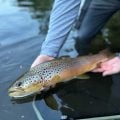Spain: “Monte Perdido”
FOR AN ANGLER, the day never holds as much promise as when viewed from midstream at first light. When I stepped into the river the world was still shades of gray. But with the lightening sky, shapes flat and indistinct became bankside willows, yellow and pale green; peaks ochre and brown and slate; sand and gravel bars bleached-bone white and flecked with silver mica.
The Ara begins as a trickle among the jagged peaks in and around Ordesa y Monte Perdido National Park. It is here in this wild, inhospitable region of the Spanish-French frontier that the Pyrenees reach their greatest height — Pico de Posets, 11,065 feet; Pico de Aneto (Spain’s second-highest peak), 11,168 feet.
 From a mountain freshet at its source, the Ara soon swells to a swift stream. Near the southwest entrance to the park it converges with the Araza — plunging from the forbidding 10,997-foot summit of Monte Perdido — and, doubling its volume by the confluence, tumbles over smooth-worn rocks toward Torla.
From a mountain freshet at its source, the Ara soon swells to a swift stream. Near the southwest entrance to the park it converges with the Araza — plunging from the forbidding 10,997-foot summit of Monte Perdido — and, doubling its volume by the confluence, tumbles over smooth-worn rocks toward Torla.
In the morning chill I had pulled a sweatshirt over my standby flannel. But standing in the glacial water I was cold. It was mid June, not even summer yet, still the early days of a season all too brief. By July the water would warm slightly, the big insect hatches would start. Then the weeks would gain speed, running away into August, down to a swift end. In the High Pyrenees, from September to June the trout are left alone.
I changed flies, blowing on my hands to tie the clinch knot. With the sun edging up over the mountains I hooked and released a 10-inch brown amid a series of small rapids and riffles. A few dozen yards upriver, the only other fisherman up and about caught four in quick succession on a silver spinner. I watched him slip two into his creel.
I kept casting and moving upstream, working the main flow, but rose nothing. I tried the edges and, as the sun climbed higher, I had a hit, just a small splash behind the fly as it drifted in near the willows. But when I tried the same drift another half dozen times there was nothing. I climbed out of the river and sat down to rest among the willows. The day was progressing, the fish were not biting: it was time to move. I headed downstream.
Just above Torla the river is funneled into a narrow canyon where it becomes a deep, swirling, churning torrent, nearly impossible to get to and even harder to fish. But standing on the footbridge below the canyon I knew I had to try.
Non-anglers scoff at tales of fish-rich waters detected by smell. But I have experienced it many times, from Cape Cod Bay when a school of blues was nearby to a mountain lake in Idaho’s Sawtooths, where 6- to 10-inch brook trout fought each other to hit any fly that was tossed out. On the Ara, the smell of trout hung heavy in the mist-filled gorge above Torla. To fish it, however, was another matter.
The right bank was sheer rock walls — out of the question. But along the left bank for about 50 feet there was a narrow shelf between the cliffs and the river. I climbed down from the bridge and edged along the rock. I struggled with the problem for most of an hour, but with no room to wade and rock walls thwarting a backcast, it approached an exercise in existential futility. Finally I gave it up as a worthy but unattainable goal.
When the Ara emerges from the canyon south of Torla its gradient flattens out, it becomes gentler and more accessible.
But it is below Broto, the next village, that the Ara is loveliest and most fishable. A stretch of several miles is reachable from a gravel road that runs along the west bank from Broto south. Here it is a big, smooth-flowing stream with a gravel-and-cobble bed and occasional sandbars. Much of this section is wadeable and the banks are alternately brushy and clear, offering easy access.
The broad, sparsely populated valley, the meandering river and the mountains are reminiscent of Wyoming. Farther west, in Navarre, the Pyrenees drop several thousand feet and the countryside becomes green and lush, watered by the mists and rains blowing off the Bay of Biscay. But the Aragon Pyrenees are rougher, drier country.
Cliffs and jagged peaks tower above sunlit pine forests and the region abounds in wildlife. Near Sarvise I watched an eagle spiral down and land a couple of hundred yards upstream. Bears, ibex, chamois and deer roam the high country. There may even be a few wolves left. The reality belies the cliche of Europe as densely populated and unrelentingly urbanized.
But though the natural landscape resembles the American West, other features — the ancient towns, traditions, timeworn byways — draw sharp distinctions. It is a compelling dual ambience: wildness juxtaposed with the milleniums-old continuity of European civilization. The rivers, the mountains are timeless. And did Roman legionnaires tread this rocky trail? Was it Crusaders who built those fortress walls?
On a late-spring afternoon, the river between Broto and Sarvise is a mercurial ribbon under a platinum sun. After my hard-fishing morning, Dave and had I enjoyed a leisurely lunch. Then we drove down to Broto, crossed a steel bridge to the west bank, and parked at the edge of the gravel road near the river. Dave had had enough of tagging along waiting for me to catch something so he sat in the car fiddling with the radio while I geared up and checked out the river.
Here the Ara was a series of swift riffles and mini-rapids. Viewed from atop the riverside berm, it looked problematic but not unfeasible. But when I stepped in to cross I found the water was deeper than it looked and I would be risking a dunking to wade it.
I could see that, about 200 yards downstream, the river flattened out, so I climbed back up the bank and started walking. The ground became thick with brush and rose in a small hummock as I followed the curve of the river.
After going about 150 yards, I pushed through a patch of woods and found myself standing at the edge of a 10-foot sandbank looking down into a slick pool. Directly below, a 13- or 14-inch brown was casually feeding. I got down on my stomach and watched like a voyeur.
Cut off from the river’s main flow by a narrow sandbar, the pool was a tranquil backwater 40 feet long and a dozen feet wide. Upstream, a foot-wide channel funneled a swift, slender stream from the greater current into the head of the pool, washing in richly oxygenated water and serving as a fluid conveyer belt of trout food. At the tail of the pool the water whooshed out a narrow sluice back into the main channel.
Barely beneath the surface and three or four feet downstream from the inlet channel the fish hung suspended in the flow. In the gentle current it held its position effortlessly, barely fanning its tail, tipping up or drifting slightly left or right to sip an insect or examine a piece of flotsam.
The morning’s action had been more than slow. It had been nearly dead. I wanted this fish and wracked my brain for a plan. For a couple of hundred feet upstream and down the bank was too high and steep for me to get down it. I could dap for the trout like a kid on a sunfish pond, but it would be a ludicrous undertaking trying to haul the fish up the bank flopping and bouncing on a flimsy tippet.
Twenty feet to my right, downstream from the fish, was a big pine barely clinging to the edge of the bank. I marked the spot, then hiked another 100 yards or more downriver. Here the bank was only three feet high and I eased down the slope into the stream. I was focused on getting to the spot near the pine and made only perfunctory casts as I worked my way upstream. But I could not rush. The bankside channel was near the top of my boots and toward the middle the river deepened down to fast water over slippery cobbles.
In my impatience — wading hastily and too far between casts — I spooked a trout close in by the bank. I did not see it until it shot out into the main current. Then I spooked another, almost underfoot. I stopped for half a minute and talked to myself.
“You came a long way, it’s been a great trip, slow down.” But the lecture had little effect and in five more minutes I was almost below the pine and watching the water ahead.
I made a couple of casts, moving slowly upstream, then spied a dimple on the water 30 feet ahead. I took another step and my right foot sank into soft sand. I felt a trickle of water down my leg and stepped up onto a rock, still watching the fish and not my footing. Both feet shot out from under me and I fell backward with a splash, ending up sitting down in the water up to my chin, slowly floating downstream.
The cold took my breath away for an instant but I used the rod for balance and quickly regained my feet, clothes dripping and clinging like baptismal raiments, boots filled to the brim. I started to curse and then laughed and laughed. “Too fish hungry,” I said. “You got too goddamn fish hungry.”
Half a minute later, still intent on stalking the fish, I looked up to see a tough-looking character with a face of old cordovan and a badge pinned to his shirt standing on the bank 20 yards upriver and motioning me over.
As in most places, Spain requires that you carry your license with you but, foolishly, I had left mine in the car. “Licencias de pesca,” he said when I sloshed ashore. “Auto,” I answered, pointing up the gravel road. He probably heard it from poachers all the time: Left my license in the car.
His eyes got dark and I could not understand the words he started yelling but with the help of his hand gestures I got the picture all right: Keep your license in your shirt pocket.
Then he noticed the fly rod. He checked the tippet and, seeing the dry fly, gave me a quizzical look and nodded and some of the hardness went out of his eyes. We marched back together, water sloshing out of my boots with every step. Dave was sitting in the car reading and still fiddling with the radio. He watched us coming but did not say anything when we walked up.
When I pulled the license out of the glove compartment the warden broke into a broad smile and motioned for me to open my fly box. He raised his eyebrows, chuckled and shook his head at the “muy grande” No. 10 mayflies and yellow Wulffs. But some of the smaller flies — blue duns, gray duns and light Cahills in 14 and 16 — were “muy bueno.”
He pointed to himself, then the fly box, made a casting motion and held up three fingers: “Solamente tres.”
I thought for a moment and could not figure it out. But when he repeated the gesture I got it: He fished with only three flies. After a few more minutes of angling talk he headed back down the road to his Land Rover, wishing me luck with a wave and a grin.
When he had gone I sat on a rock, pulled off my boots and poured out a couple of gallons of water. I took off my pants and shirt and socks and wrung them out the best I could, laid them out on rocks in the sun and got dry ones from my backpack. Then I had a sandwich and a soda sitting in the car with Dave.
“What was that you said yesterday? Who’s gonna check way up in the mountains?” I said. We both laughed and he told me he had gotten a shot of my dunking.
“I think we should title it ‘The Intrepid Angler.’ ”
“Or the ‘Spastic Caster,’ ” I said.
I returned to the river, still resolutely ignoring the axiom that most trout are caught within a few hours of sunrise or sunset. The sun was warm, the air dry and brilliantly clear and I was content to feel the cool surge of the river against my boots and follow the motion of the line against the vast blue sky. As the sun traced its descending arc, curving down toward the jagged skyline, transmuting the river to tarnished silver and finally blue-black steel, there were no minutes, no hours, no time even — only change.
At dusk the valleys of the Pyrenees cool quickly as mountain shadows lengthen across them. I had begun to feel the river’s chill and was casting by rote, resigned to a fishless finish. Pick up, back, stop, forward, stop, strip. . . . pick up, back, stop, forward, stop, strip. . . . SMASH.
The fish tore across in front of me, thrashing at the surface as it went. In three or four seconds it was surging toward the willows that overhung the right bank. I put on more pressure, stopping the run, but had to ease off and let it go when I felt the strain on line and leader. The trout splashed with its tail and then it was in under the branches.
I kept the rod high but in a moment the line was caught. I quickly walked up, reeling in the slack. When I bent over and reached in under the willow branches to the snag, I could see the flash of the fish among the leaves that trailed in the current. I gave a tug on the dead branch and broke it loose and the fish shot off downriver, revving the reel spool like a dragster engine before the light turns green.
Swimming with the current the trout had more power, but in another minute it was finished and I eased it up onto shore. It was a thick, solid fish, with the dark coloration of some wild browns. In the waning light, shimmering bronze against the clean-washed gravel, it was a living piece of the river.
The next morning Dave and I packed up and started the trek back to civilization.











